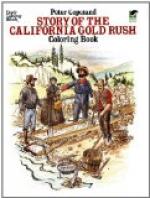In the high Sierras are found strange and pretty blossoms unlike the flowers of valleys and sea-coast. There you will see the mountain-heather with pink, purple, or dainty white bells, the goldenrod, and gentians blue as the sky. Strangest of all is the snow-plant. This curious thing sends up a thick, fleshy spike a foot or so in height and set closely with bright scarlet flowers. It grows where the snow has just melted round the fir trees, and leaf, stem, and blossom are all the same glowing red.
Most of the valley and coast wild-flowers bloom and ripen their seeds before the dry summer begins. Such plants die and wither away in the heat, but their seeds are safe on the warm ground till fall rains soak the earth and set them growing again. In the high mountains a thick blanket of snow covers the sleeping seeds till May or June, and then sunshine wakes them once more.
[Illustration: “Wawona” (28 feet in diameter).]
[Illustration: The grizzly giant (33 feet in diameter).]
No doubt you have seen many of our shrubs or tall bush-plants in your vacations. Do you remember the sweet creamy white azaleas and the buckeyes that grow along the creeks in the redwoods? And the feathery blue blossoms of the wild lilac crowding in close thickets up the hillsides? One of our shrubs is a holiday visitor, the Christmas-berry, whose bright-red clusters trim your house at that gay, happy season. The manzanita is another pretty bush, with pink bells that ripen to small scarlet apples in the fall.
Usually, these and other shrubs cover the hillsides with a thick, matted tangle of stems and branches almost impossible to get through. This chaparral, as the Spanish called it, clothes the foot-hills and mountain sides with a close growth through which deer and bears alone can travel and make trails or runways. Great stretches of buckthorn in the north, and of sage-brush in the south, cover the wild lands, while in the sandy desert tall, prickly cactus, yucca, and mesquite grow with the sage-brush in the blazing sun.
Only a few of California’s wild plants and flowers have been now called to your notice. But children have sharp eyes, and you will find many more to inquire about in your vacation days. Then the blackberries and thimble-berries will be ripe, and the pink salmon-berry in the redwoods. Perhaps you will look for and dig up the soaproot, that onion-like bulb of one of the lily family with which the Indians make a soapy lather to wash their clothes. Let us hope you will know and keep away from the “poison-oak,” the low bush with pretty red leaves, for its leaves are apt to make your skin swell up and blister wherever they touch you.
What a long and pleasant story might be told you of our state’s real gardens! Perhaps your teacher will give you an hour to talk about your home gardens, and to see how much you can tell about them. You may have flowers the year round, if you live on the coast, or in the warm valleys where no Jack Frost comes with his icy breath to kill the tender plants. In such genial climates roses and geraniums bloom all year, and only rest when the gardener cuts them back; and most of the shrubs and trees in parks and gardens are always fresh and green.




